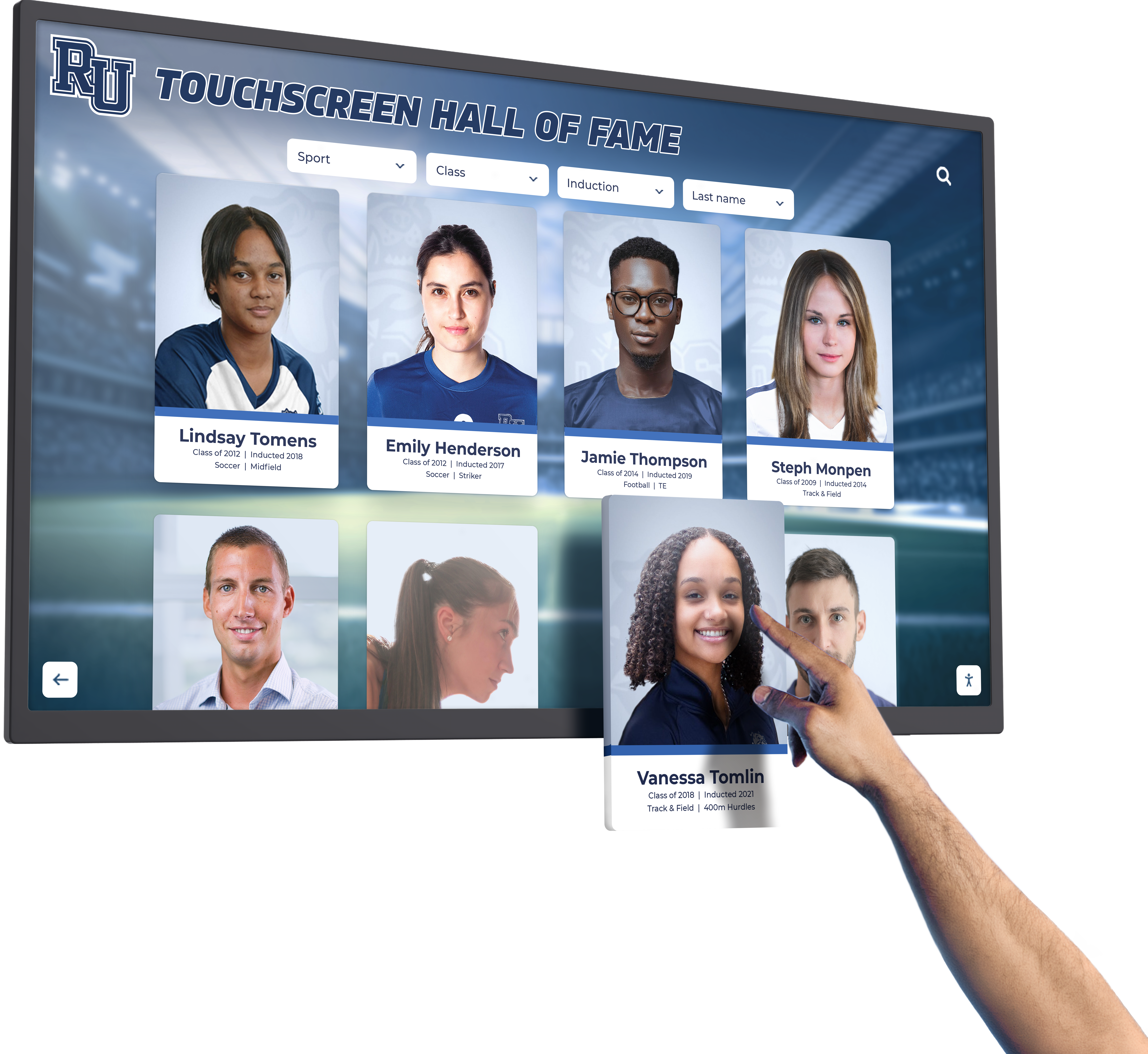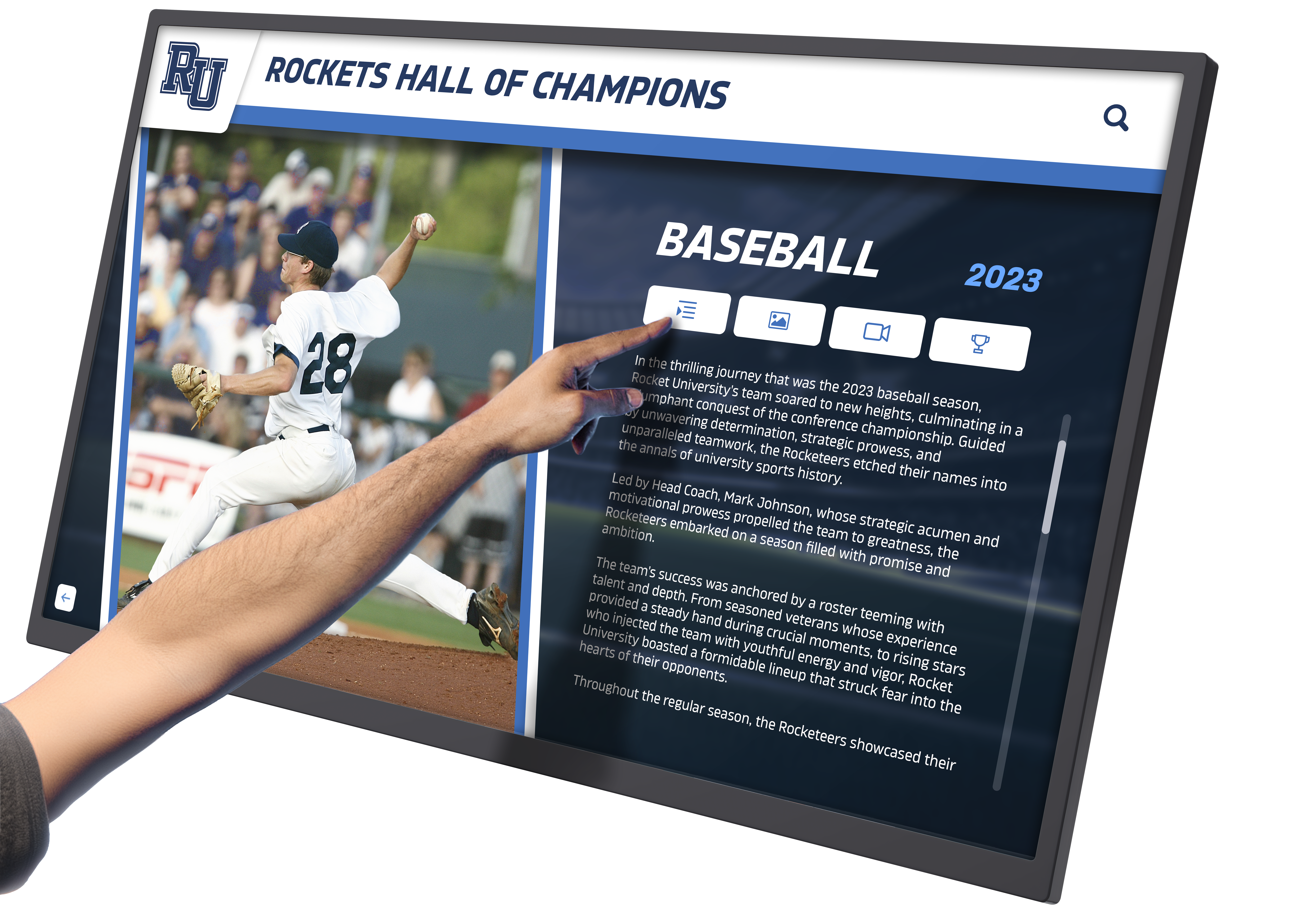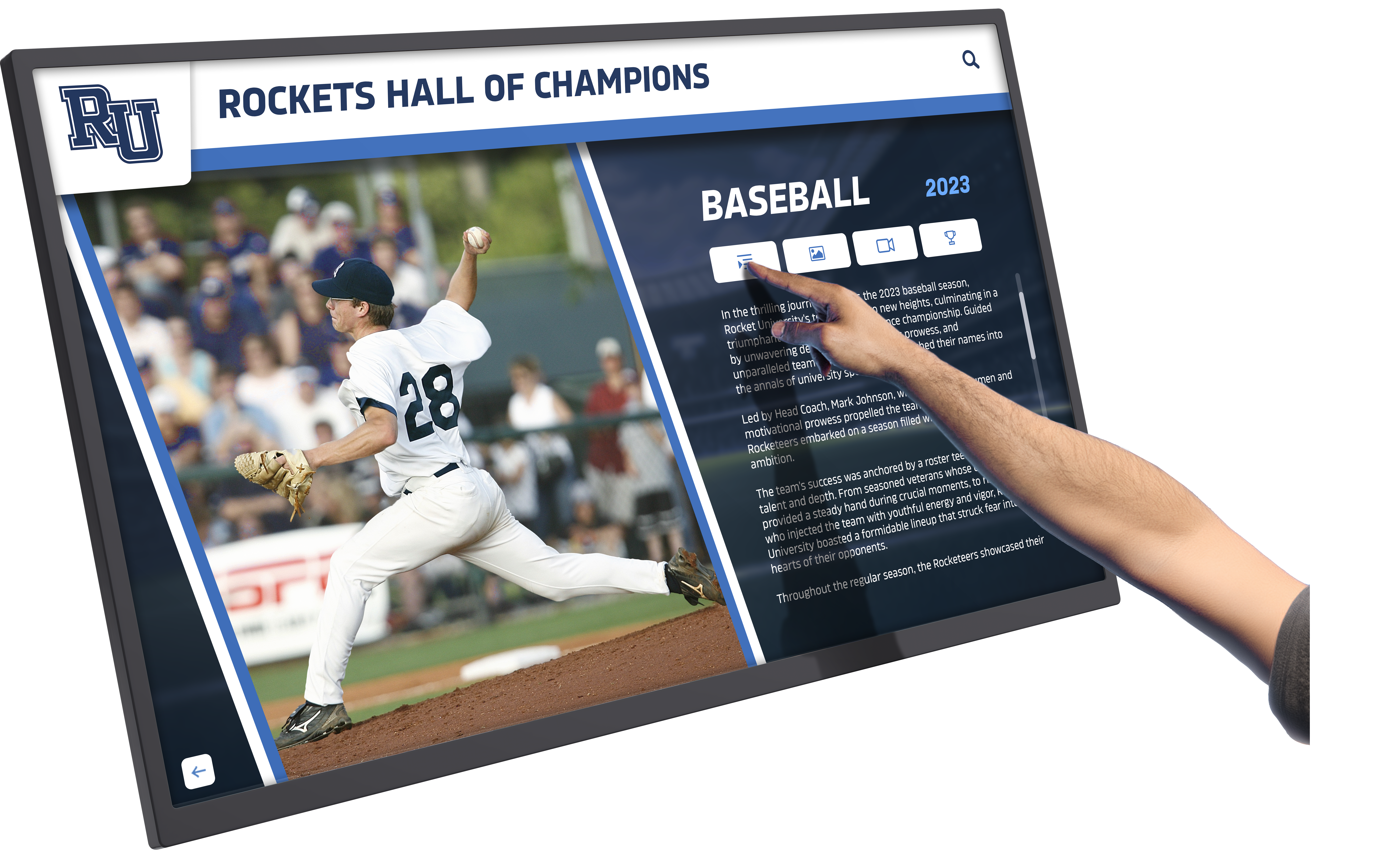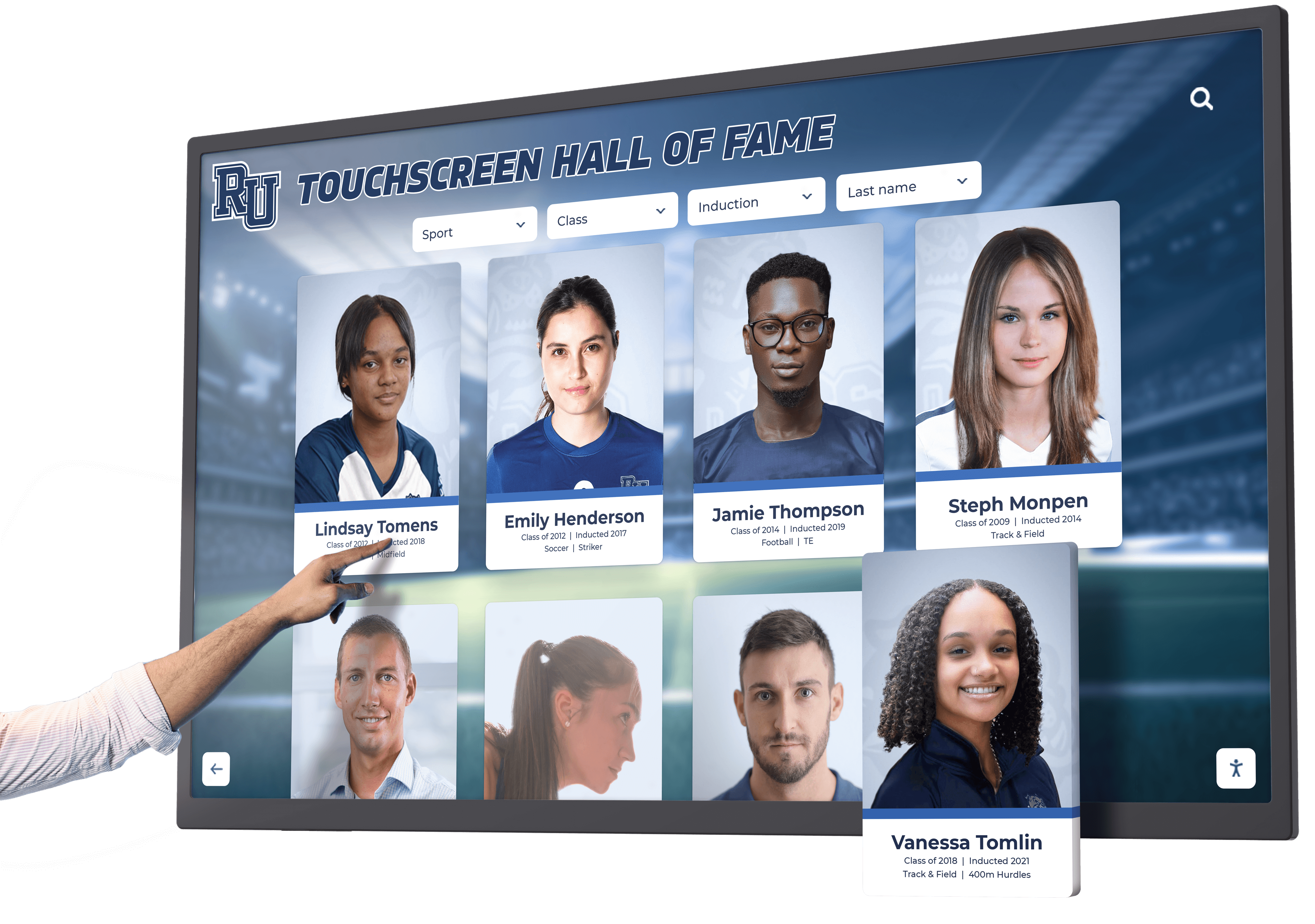Key Takeaways
Discover how touch kiosk hall of fame displays transform recognition programs. Learn about interactive features, installation considerations, content strategies, and engagement benefits for schools, universities, and organizations.
Understanding Touch Kiosk Hall of Fame Systems
Touch kiosk hall of fame displays represent a significant evolution from traditional recognition methods, offering interactive experiences that engage visitors while honoring achievements comprehensively.
What Makes Touch Kiosks Different
Traditional hall of fame displays—plaques mounted on walls, framed photos in corridors, or trophies in glass cases—provide static recognition that viewers glance at briefly before moving on. Touch kiosks transform this passive experience into active engagement:
Interactive Exploration
- Visitors control their experience through intuitive touch navigation
- Advanced search capabilities help find specific people or achievements
- Multiple content layers reveal detailed stories beyond surface information
- Multimedia integration brings recognition to life with video and audio
Unlimited Recognition Capacity
- Recognize thousands of individuals within a single display footprint
- No physical space constraints limiting who receives recognition
- Easy addition of new inductees without construction or installation
- Comprehensive historical archives spanning decades or centuries
Dynamic Content Management
- Real-time updates without physical production or installation
- Corrections and additions made instantly as information becomes available
- Seasonal features highlighting relevant achievements
- Living recognition that grows and evolves over time

Core Components of Effective Touch Kiosks
Successful touch kiosk hall of fame implementations combine hardware, software, content, and design into cohesive systems that deliver engaging experiences:
💻 Commercial-Grade Hardware
Professional touchscreens designed for continuous operation in high-traffic environments with durability and reliability
🎨 Intuitive Software Interface
User-friendly navigation enabling visitors of all ages and technical abilities to explore content easily
📚 Compelling Content
Rich profiles featuring photos, videos, biographies, and achievements that tell complete stories
🎯 Strategic Design
Custom branding, intuitive layout, and visual hierarchy that guides visitors through content naturally
Understanding these components helps organizations evaluate solutions and make informed decisions when implementing touch kiosk hall of fame displays.

Key Benefits Driving Touch Kiosk Adoption
Organizations across education, corporate, nonprofit, and community sectors are implementing touch kiosk hall of fame systems for compelling reasons that deliver measurable value:
Enhanced Visitor Engagement
Touch kiosks fundamentally change how people interact with recognition displays. Rather than walking past static plaques with brief glances, visitors stop, explore, and engage deeply with content:
Increased Dwell Time
- Traditional displays: 5-15 seconds average viewing time
- Touch kiosk displays: 3-8 minutes average interaction time
- Active engagement creates stronger emotional connections
- Extended exploration leads to discovery of unexpected content
Multi-Generational Appeal
- Digital-native younger visitors appreciate intuitive touch interfaces
- Older generations discover easy navigation with clear instructions
- Accessibility features ensure inclusive experiences for all abilities
- Family groups explore together, spurring conversations and connections
The engagement advantages of interactive hall of fame displays create meaningful interactions that static recognition methods cannot match.
Operational Efficiency and Cost Savings

While initial investment in touch kiosks exceeds traditional recognition methods, long-term economics strongly favor digital solutions:
Reduced Per-Inductee Costs
- Traditional plaques: $250-500 per inductee for materials and installation
- Touch kiosk additions: No incremental cost to add new profiles
- 50 inductees over 10 years: $12,500-25,000 traditional vs. included in touch kiosk
Eliminated Update Expenses
- No fabrication costs for new plaques or nameplates
- No installation labor for physical mounting
- No wall modifications or expansion construction
- Instant updates through content management systems
Space Utilization Benefits
- Single display recognizes unlimited individuals
- Valuable wall space available for other purposes
- No expansion construction as recognition programs grow
- Prime locations possible without space constraints
Comprehensive Recognition Capabilities
Touch kiosk systems enable recognition breadth and depth impossible with physical displays:
Rich Individual Profiles
- Professional biographies detailing achievements and contributions
- Multiple high-resolution photos spanning careers and milestones
- Video interviews sharing personal perspectives and advice
- Achievement timelines showing career progression
- Links to external resources, publications, or portfolios
- Contact preferences enabling networking and mentorship
Multiple Recognition Categories
- Alumni achievement across all fields and industries
- Athletic accomplishments and record holders
- Academic excellence and scholarly contributions
- Donor recognition and philanthropic impact
- Faculty and staff service milestones
- Community service and volunteer leadership
Historical Documentation
- Comprehensive institutional history spanning decades
- Evolution of programs, facilities, and traditions
- Archival photos and documents preserved digitally
- Oral histories captured in video interviews
- Context explaining achievements within their eras

Solutions like digital hall of fame displays from Rocket Alumni Solutions provide platforms specifically designed to showcase these rich, comprehensive profiles that honor individuals appropriately.
Planning Your Touch Kiosk Hall of Fame Implementation
Successful touch kiosk deployments begin with thoughtful planning that considers objectives, locations, audiences, content, and integration with broader recognition strategies.
Defining Recognition Program Objectives
Clear objectives guide all subsequent implementation decisions:
Primary Recognition Goals
- Honor distinguished achievements and inspire current community members
- Strengthen connections between past and present generations
- Celebrate organizational history and evolution
- Support development efforts through donor recognition
- Enhance institutional pride and community identity
Engagement Objectives
- Create compelling visitor experiences in main facilities
- Provide accessible recognition for distributed audiences
- Encourage regular interaction rather than one-time viewing
- Generate social media sharing and word-of-mouth promotion
- Facilitate connections between visitors and recognized individuals
Operational Goals
- Streamline recognition processes and reduce administrative burden
- Lower long-term costs compared to traditional methods
- Enable rapid updates as new information becomes available
- Integrate with existing databases and information systems
- Measure engagement and demonstrate recognition program value
Strategic Alignment
- Support advancement and fundraising priorities
- Enhance recruitment and marketing initiatives
- Strengthen alumni relations and engagement programs
- Complement broader campus or facility improvements
- Advance diversity, equity, and inclusion commitments
Clear objectives create frameworks for evaluating options, measuring success, and optimizing recognition programs over time.
Location and Installation Considerations
Touch kiosk placement profoundly impacts engagement levels, with strategic positioning maximizing visibility and interaction:
Optimal Location Characteristics
High Traffic Areas
- Main entrances and lobby spaces
- Common areas where people naturally gather
- Corridors connecting heavily-used facilities
- Near elevators or stairwells with natural pauses
- Adjacent to dining facilities or student centers
Appropriate Environments
- Climate-controlled spaces protecting equipment
- Adequate lighting without excessive glare on screens
- Sufficient space for groups to gather comfortably
- Nearby power and network connectivity
- Secure locations minimizing vandalism risk
Strategic Positioning
- Visible from multiple approach angles
- Not competing with other major displays or attractions
- Comfortable viewing height and angle for standing visitors
- Wheelchair-accessible with appropriate mounting height
- Near seating for extended exploration when available
Integration with Spaces
- Complementary to architectural style and décor
- Proper proportion relative to surrounding elements
- Professional appearance reflecting institutional standards
- Custom enclosures matching facility aesthetics
- Branded elements reinforcing organizational identity
Organizations implementing touchscreen kiosk software should evaluate multiple potential locations, considering traffic patterns, technical requirements, and strategic visibility when making placement decisions.

Hardware Configuration and Technical Requirements
Touch kiosk implementations involve important hardware decisions balancing budget, functionality, aesthetics, and technical capabilities:
Display Size and Type
- 43"-55" Displays: Compact installations in space-constrained areas, suitable for individual interaction
- 55"-65" Displays: Balanced size for most applications, comfortable for small groups
- 65"-86" Displays: Large format for spacious areas or dual-screen configurations
- Commercial-Grade Panels: Professional displays rated for 16+ hours daily operation
- Capacitive Touch: Responsive, multi-touch capability supporting intuitive gestures
Mounting and Enclosure Options
Wall-Mounted Configurations
- Clean, professional appearance maximizing floor space
- Permanent installation with secure mounting systems
- Integration with existing walls or custom millwork
- Cable management systems for professional finish
- Optimal for: Finished spaces with suitable wall locations
Freestanding Kiosks
- Portable or fixed-position floor installations
- All-in-one enclosures with integrated computers and power
- Flexibility to relocate as needs evolve
- Often include security features and cooling systems
- Optimal for: Open spaces, temporary installations, or future relocation needs

Computer and Connectivity
- Integrated computer modules or separate media players
- Adequate processing power for smooth video playback and navigation
- Reliable network connectivity (wired Ethernet preferred over WiFi)
- Remote management capabilities for monitoring and updates
- Backup power protection preventing unexpected shutdowns
Comprehensive computer module for touchscreen kiosk selection ensures reliable performance and simplified maintenance over the system’s lifespan.
Software Platform and Content Management
The software platform powering touch kiosk hall of fame displays determines ease of use, capabilities, and long-term satisfaction:
Essential Platform Capabilities
🖱️ Intuitive Content Management
Non-technical administrators easily add, edit, and organize content without coding knowledge or technical expertise
🎥 Multimedia Support
Seamless integration of photos, videos, documents, and audio content in various formats and resolutions
🔍 Powerful Search
Multiple search dimensions helping visitors find specific people, achievements, time periods, or categories
📊 Analytics and Reporting
Engagement metrics revealing popular content, usage patterns, and opportunities for optimization
🎨 Custom Branding
Full customization matching organizational branding, colors, logos, and visual identity
☁️ Cloud-Based Management
Remote content updates, automatic backups, and access from any location with internet connectivity
Rocket Alumni Solutions offers purpose-built touchscreen software designed specifically for recognition applications, providing advantages over generic digital signage platforms adapted for hall of fame purposes.
Content Development Strategies for Touch Kiosks
Technology alone doesn’t create compelling recognition—thoughtful content strategy ensuring comprehensive, engaging profiles drives success and visitor satisfaction.
Creating Rich Individual Profiles

Effective individual profiles combine multiple content elements telling complete stories:
Visual Content
- Professional headshot (current or from recognition era)
- Career photos showing work and achievements
- Candid images revealing personality
- Historical photos from student or early career days
- Award ceremonies and recognition events
Biographical Content
- Compelling narrative overview (300-500 words)
- Education history and academic achievements
- Career progression and professional milestones
- Major accomplishments and contributions
- Community service and volunteer activities
- Personal information (when appropriate and authorized)
Multimedia Elements
- Video interviews (2-5 minutes optimal length)
- Audio clips from speeches or presentations
- Document excerpts from publications or work
- Photo galleries with multiple images
- Links to external resources and portfolios
Achievement Documentation
- Specific honors, awards, and recognition received
- Statistical achievements and record-breaking performances
- Published works, patents, or creative output
- Leadership positions and organizational roles
- Impact measurements and outcomes achieved
Content Collection and Development Processes
Gathering comprehensive content for touch kiosk profiles requires systematic approaches:
Direct Outreach to Inductees
- Request biographical information, photos, and videos directly
- Provide clear guidelines on content needs and specifications
- Offer submission templates ensuring consistent information
- Include approval processes for profile review before publication
- Maintain ongoing communication for updates and corrections
Archival Research
- Review institutional records, publications, and historical documents
- Digitize relevant materials from physical archives
- Interview current staff or community members with institutional knowledge
- Consult yearbooks, newsletters, and other historical sources
- Verify factual accuracy through multiple sources when possible
Crowdsourced Contributions
- Enable community members to submit photos, stories, and information
- Implement moderation processes ensuring quality and appropriateness
- Create opportunities for alumni to contribute during reunions or events
- Leverage social media to request specific content or information
- Acknowledge contributors appropriately when content is used
Organizations developing content for digital recognition displays should establish clear workflows, quality standards, and approval processes ensuring consistency and accuracy across all profiles.

Organizing Content for Discovery
Effective organization helps visitors find content easily while encouraging exploration:
Primary Navigation Structures
Chronological Organization
- Browse by decade or specific year ranges
- View inductees in order of induction
- Compare achievements across different eras
- Understand evolution of programs over time
Categorical Organization
- Filter by achievement type or field
- View all athletic versus academic honorees
- Explore specific industries or professions
- Compare contributions in similar domains
Alphabetical Navigation
- Traditional name-based browsing
- Quick location of specific individuals
- Surnames organized clearly
- Alternative name handling for married names
Search Functionality
- Free-text search across all content
- Filtered searches by category, year, or field
- Advanced search combining multiple criteria
- Suggested results as users type
Secondary Discovery Mechanisms
- Featured profiles highlighting recent inductees or special achievements
- Randomized “spotlight” presentations introducing visitors to diverse content
- “Related people” connections showing classmates, teammates, or colleagues
- Timeline views showing multiple people’s careers in parallel
- Geographic mapping showing where alumni have lived or worked
Thoughtful organization combined with powerful search creates both directed discovery (finding specific people) and serendipitous exploration (stumbling upon unexpected connections) that maximize engagement.
Maximizing Engagement and Impact
Touch kiosk implementation is just the beginning—ongoing optimization and promotion ensure recognition programs achieve their full potential:
Launch Strategy and Community Introduction
Successful launches create awareness, generate excitement, and establish patterns of regular engagement:
Pre-Launch Activities
- Build anticipation through email campaigns and social media teasers
- Create countdown messaging highlighting featured content
- Invite inductees and stakeholders to preview events
- Prepare promotional materials (signage, handouts, digital assets)
- Train staff on basic navigation to assist visitors
Launch Event Considerations
- Unveiling ceremony with key stakeholders and recognized individuals
- Ribbon cutting or similar symbolic opening
- Guided demonstrations showing key features
- Scheduled times for inductees to view their profiles
- Media coverage generating broader awareness
- Social media promotion encouraging sharing and discussion

Ongoing Promotion
- Regular email updates highlighting new inductees or featured profiles
- Social media posts showcasing interesting stories or milestones
- Integration into tours, orientations, and special events
- QR codes enabling instant access on personal devices
- Physical signage directing visitors to kiosk locations
Measuring Success and Optimization
Comprehensive measuring digital hall of fame success requires tracking both quantitative metrics and qualitative feedback:
Quantitative Engagement Metrics
Usage Statistics
- Total interactions per day/week/month
- Average session duration per visitor
- Number of profiles viewed per session
- Peak usage times and patterns
- Repeat visitor identification (where technically possible)
Content Performance
- Most-viewed individual profiles
- Most-popular recognition categories
- Most-used search terms and filters
- Video view completion rates
- External link click-through rates
Technical Performance
- System uptime and reliability
- Navigation responsiveness and speed
- Error rates or technical issues
- Network connectivity consistency
- Hardware performance and temperature
Comparative Benchmarks
- Month-over-month usage trends
- Year-over-year engagement growth
- Performance versus institutional goals
- Comparison to similar institutions (when available)
Qualitative Assessment
- Visitor comments and feedback (in person or through surveys)
- Stakeholder satisfaction from inductees and families
- Social media mentions and sentiment
- Integration with broader institutional objectives
- Staff observations of visitor behavior and engagement
Analytics capabilities built into solutions like Rocket Alumni Solutions provide comprehensive data for optimization while respecting visitor privacy appropriately.
Content Refresh and Ongoing Management
Touch kiosks require ongoing content management maintaining freshness and relevance:
Regular Content Updates
- Add new inductees according to recognition schedule
- Update existing profiles with recent achievements or milestones
- Correct errors or inaccuracies as they’re discovered
- Enhance profiles with additional content as it becomes available
- Archive deceased inductees appropriately with memorial information
Seasonal and Thematic Features
- Highlight inductees relevant to current events or seasons
- Feature alumni during reunion weekends or homecoming
- Showcase specific categories during relevant months or celebrations
- Create special collections around themes or milestones
- Rotate featured content ensuring regular changes
Technical Maintenance
- Software updates and security patches applied regularly
- Hardware cleaning and inspection schedules
- Network connectivity monitoring and optimization
- Backup verification ensuring content protection
- Proactive monitoring preventing issues before they impact visitors

Integration with Broader Recognition Strategies
Touch kiosk hall of fame displays deliver maximum value when integrated thoughtfully with comprehensive recognition programs:
Complementary Recognition Methods
Touch kiosks work alongside rather than replacing other recognition approaches:
Physical Recognition Elements
- Small plaques or nameplates providing permanent physical presence
- Trophy displays showcasing actual awards and memorabilia
- Photo galleries in hallways showing recent inductees
- Donor walls recognizing major gift contributors
- Athletic record boards celebrating performance achievements
Digital Extensions
- Public website sections mirroring kiosk content for remote access
- Mobile apps providing on-the-go exploration
- Email newsletters highlighting featured inductees
- Social media campaigns sharing stories and achievements
- Virtual tour integration for remote visitors

Event Integration Opportunities
Touch kiosks enhance special events and programs:
Reunion Events
- Focal point for gatherings as alumni explore memories
- Dedicated times for class-specific browsing
- Live demonstrations showing new features
- QR codes enabling continued access after events
- Photo opportunities with personal profile displays
Fundraising and Development
- Donor recognition capabilities within same platform
- Campaign progress displays showing giving impact
- Major gift recognition announcements through kiosks
- Naming opportunity for kiosk sponsorship
- Development event centerpieces demonstrating impact
Recruitment and Marketing
- Demonstrate successful outcomes to prospective students or members
- Showcase distinguished alumni during campus tours
- Create compelling content for marketing materials
- Generate social proof of institutional quality
- Differentiate from competitors lacking similar systems
Organizations implementing alumni engagement interactive recognition displays report that integration across multiple touchpoints amplifies impact significantly compared to isolated implementations.
Common Implementation Challenges and Solutions
Understanding typical obstacles and proven solutions helps organizations avoid pitfalls and achieve successful deployments:
Challenge: Content Development Workload
The Challenge: Creating hundreds or thousands of detailed profiles requires significant time and effort, potentially overwhelming staff capacity.
Proven Solutions:
- Phased Implementation: Start with recent inductees and expand backward systematically
- Template Standardization: Create consistent profile templates reducing per-person effort
- Alumni Self-Service: Enable inductees to submit information through structured forms
- Student Involvement: Engage journalism or communications students in profile development
- Professional Services: Leverage vendor content development support for initial population
- Volunteer Contributions: Recruit retired staff or alumni volunteers for historical research

Challenge: Budget Constraints
The Challenge: Initial investment in quality touch kiosk systems may stretch institutional budgets, particularly for smaller organizations.
Proven Solutions:
- Phased Funding: Spread investment across multiple budget years
- Sponsorship Opportunities: Offer naming rights or recognition for major donors funding installation
- Grant Applications: Pursue foundation grants supporting technology or recognition initiatives
- Multi-Purpose Justification: Position kiosks serving multiple functions (wayfinding, event information, recognition)
- Comparative Analysis: Demonstrate long-term savings versus traditional recognition methods
- Pilot Programs: Start with single display demonstrating value before broader deployment
Challenge: Technical Concerns and Support
The Challenge: Non-technical staff may worry about managing technology or addressing technical issues when they arise.
Proven Solutions:
- Vendor Support Packages: Select providers offering comprehensive technical assistance and training
- Cloud-Based Management: Remote administration simplifies updates and reduces on-site technical requirements
- Intuitive Interfaces: Choose platforms designed for non-technical users with minimal learning curves
- Comprehensive Training: Ensure adequate training during implementation and ongoing refresher opportunities
- Documentation: Maintain clear procedures for routine tasks and common issues
- Remote Monitoring: Proactive vendor monitoring identifies and resolves issues before users encounter them
Solutions like those from Rocket Alumni Solutions provide white-glove support customer success services specifically addressing these concerns through dedicated support teams and comprehensive assistance.

Touch Kiosk Applications Across Sectors
While this guide emphasizes educational applications, touch kiosk hall of fame displays serve diverse sectors with similar recognition needs:
Educational Institutions
Schools and Universities
- Alumni halls of fame recognizing distinguished graduates
- Athletic halls of fame celebrating championship teams and record holders
- Academic achievement recognition for scholars and faculty
- Digital trophy displays replacing traditional trophy cases
- Historical archives documenting institutional evolution
Corporate and Business
Recognition Applications
- Employee recognition programs celebrating tenure and performance
- Leadership succession timelines showing organizational evolution
- Innovation showcases highlighting products, patents, and achievements
- Company history documentation preserving founding stories and milestones
- Corporate recognition walls in lobbies and common areas
Nonprofit and Community Organizations
Mission-Driven Recognition
- Volunteer halls of fame honoring service contributions
- Donor recognition for philanthropic support
- Community hero recognition celebrating local impact
- Historical society archives documenting community evolution
- Community accomplishments celebrating collective achievements
Religious Institutions
Faith Community Recognition
- Clergy and religious leader recognition
- Congregation history and milestone documentation
- Charitable program impact showcases
- Touchscreen software for religious institutions serving unique denominational needs
- Memorial gardens and tribute displays
Healthcare Organizations
Medical Recognition Applications
- Physician and caregiver recognition programs
- Medical innovation and research showcases
- Patient story and testimonial displays
- Donor recognition for capital campaigns
- Historical documentation of facility evolution
Each sector adapts touch kiosk hall of fame concepts to unique recognition needs while leveraging common capabilities for engagement, comprehensive content, and efficient management.
Future Trends in Touch Kiosk Recognition Technology
Touch kiosk technology continues evolving with emerging capabilities enhancing engagement and functionality:
Artificial Intelligence Integration
- Intelligent search understanding natural language queries
- Automated content suggestions based on viewing patterns
- Facial recognition enabling personalized experiences (with appropriate consent)
- AI-assisted profile generation from public information sources
- Chatbot assistance answering visitor questions
Extended Reality Experiences
- Augmented reality overlays adding dimensional content
- QR code scanning enabling smartphone AR experiences
- Virtual reality extensions for remote immersive exploration
- Mixed reality integration connecting physical and digital recognition
Enhanced Personalization
- Visitor identification through QR codes or mobile apps
- Customized content recommendations based on interests
- Bookmarking and favorites synchronized across devices
- Email or text message delivery of selected content
- Social features enabling comments and reactions (with moderation)

Advanced Analytics
- Demographic insights revealing audience composition
- Predictive analytics suggesting content optimization
- A/B testing capabilities for interface improvements
- Heat mapping showing interaction patterns
- Sentiment analysis from qualitative feedback
Deeper Integration
- Automatic synchronization with institutional databases
- Integration with fundraising and CRM systems
- Connection to social media profiles (with permissions)
- Cross-platform consistency across web, mobile, and kiosks
- API accessibility enabling third-party extensions
Organizations implementing touch kiosks today position themselves to adopt these advancing capabilities as they mature, ensuring recognition programs remain current with technological evolution.
Conclusion: Transforming Recognition Through Interactive Technology
Touch kiosk hall of fame displays represent fundamental transformation in organizational recognition, combining the permanence and significance of traditional methods with modern technology’s engagement power and operational efficiency. By enabling unlimited recognition capacity, rich multimedia storytelling, intuitive exploration, and cost-effective long-term operation, touch kiosks overcome constraints that have limited recognition programs for generations.
The benefits extend across multiple organizational priorities: enhanced engagement creates meaningful visitor experiences and strengthened community connections, operational efficiency reduces long-term costs and administrative burden, comprehensive content capabilities honor achievements appropriately, and measurable analytics demonstrate recognition program value quantitatively.
Success requires thoughtful planning, quality content development, strategic implementation, and ongoing optimization—but organizations making these investments position themselves as recognition leaders while delivering measurable value to stakeholders, communities, and recognized individuals. Whether honoring distinguished alumni, celebrating athletic achievements, recognizing donors, showcasing organizational history, or serving other recognition needs, touch kiosk hall of fame displays offer capabilities that static recognition methods simply cannot match.
As technology continues evolving, organizations implementing solutions like those from Rocket Alumni Solutions benefit not only from current capabilities but also from platforms positioned to adopt emerging innovations ensuring recognition programs remain compelling and relevant for years to come.

The question for organizations isn’t whether touch kiosk hall of fame displays offer advantages—the benefits are comprehensive and compelling. Rather, organizations must decide how to prioritize implementation, which platform best serves unique needs, and how to integrate interactive recognition with broader organizational strategies. Those taking action position themselves at the forefront of recognition evolution, ensuring current and future community members benefit from modern approaches that honor tradition while embracing technology’s power to celebrate achievements meaningfully.


























